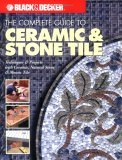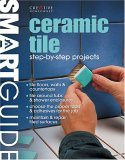Simple Tips for Maintaining your Ceramic Tile Shower
By Mark J. Donovan
|
|
A custom ceramic tile shower is a luxury bathroom feature that many homebuyers highly value. With an unlimited array of ceramic tile options and plumbing features, as well as the ability to customize the shape and size of a ceramic tile shower it is no wonder why more and more homeowners are forgoing the old fiberglass shower stall. However there is more to a ceramic tile shower than building or owning one. Knowing how to maintain a ceramic tile shower, and actually doing the maintenance, is critical for ensuring its long term charm and looks.
Tile grout is made from water, aggregates, and Portland cement and as a result it is porous. |
In addition, some types of ceramic tile, particularly unglazed ceramic tiles are also porous. Water left on ceramic tile shower walls and floors can penetrate into the grout and these certain tiles, which inevitably leads to mold and mildew growth. Once the mold and mildew take hold, particularly on the tile grout, it becomes nearly impossible to remove it. Yes there are tile and grout cleaners, both alkaline and acidic based that can remove much of the mold and mildew stains, however in many cases the results are less than perfect.
And in the case of acidic based tile and grout cleaners, they can literally eat away some of the grout.
| Properly Maintaining a Ceramic Tile Shower
To properly maintain a ceramic tile shower there are two key things that you need to do. First, it is vital that you wipe down the ceramic tile shower walls and floor after each use to remove any water from them. You can do this with a towel and/or squeegee. If the water is left on the shower walls and floor, it will soak into the grout and/or tile and breed mold and mildew in short order. The next item on the list for maintaining a ceramic tile shower is to seal the tile and grout periodically. This should be done when the ceramic tile shower is first installed and then off and on every 1 to 2 years. Again, not all ceramic tile is porous. If your shower is constructed using glazed tile you may only need to seal the grout lines. |
 |
If your ceramic tile is using unglazed ceramic tiles you may need to seal both the tile and grout. To confirm if the tile needs to be sealed, dab a little water on the tile and see if it turns a darker color. If it does, then you need to seal the tile as well as the grout.
There are many different tile and grout sealers on the market to choose from. Some are latex and acrylic based, and others are mineral based. The mineral based ones have a strong smell, so I would recommend using the latex or acrylic based tile and grout cleaners.
For information on installing a shower pan membrane liner for a ceramic tile shower, see the Shower Pan Membrane Liner Installation Ebook from HomeAdditionPlus.com. The Shower Pan Membrane Liner EBook will quickly teach you the step-by-step process for installing the shower pan membrane liner correctly. It includes instructions on framing the shower stall, pouring the pre-slope and shower base mortar, and installing the shower pan membrane liner.
See HomeAdditionPlus.com’s Ceramic Tile Calculator
See my “How to Tile a Custom Ceramic Tile Shower” Ebook to learn how to tile your own shower: For a detailed set of instructions on tiling a shower floor and walls, including pictures for every step in the process, see my “How to Tile Custom Ceramic Tile Shower Ebook”.
Related Information
Additional Ceramic Tile Resources from Amazon.com
 |
 |
 |
Get Free Bathroom Remodeling Price Quotes with No Obligation!
Fill out our 3-5 minute quick and easy form, and receive a free price quote on a bathroom remodeling project from one of our pre-screened and licensed bathroom remodeling contractors. This process is free and there is no obligation to continue once you receive your bathroom addition price estimate.

